Synchronization modes of an EtherCAT slave
 | Information for advanced user The following information is not necessary for standard applications! Extended basic knowledge of CoE (CAN over EtherCAT) and a deeper understanding of the EtherCAT protocol are required in order to utilize the following information. |
Note | |
Attention! Modification of parameters can have undesired effects! Imprudent manipulation of the parameters described below can impair the functionality of the EtherCAT slave. |
An EtherCAT slave is an electronic device that carries out cyclical sequences of calculations and/or data copying tasks at a certain interval (cycle). The EtherCAT slave working cycle (e.g. in the range of a few µs up to several ms) can be derived from different sources. Several EtherCAT slaves and/or the EtherCAT master can be operated synchronously, e.g. via the Distributed Clocks procedure. Associated examples were already mentioned in the introduction page for distributed clocks.
Synchronization or tuning does not refer to physical coupling of a processor cycle for electronic equipment in the MHz or GHz range. Instead it refers to starting of tasks at a higher logical level based on the parameters described below. Examples for such tasks are: Setting outputs, reading inputs, copying memory, initiate calculations, etc.
The following synchronization modes are described in this document:
- Free Run - the EtherCAT slave is not synchronized with EtherCAT. The slave operates autonomously based on its own cycle and is not synchronized with the EtherCAT cycle.
- Synchronous with SM event - the EtherCAT slave is synchronized with the SyncManager 2 (SM2) event (if the cyclical outputs are transferred) or the SM3 event (if only the cyclical inputs are transferred). The SM2/SM3 event is triggered by the SyncManager when a passing frame is processed.
- Synchronous with SYNC event (distributed clocks) - the EtherCAT slave is synchronized with the SYNC0 or SYNC1 event of the distributed clock system. This type of application was already described in detail above.
All parameter described below are listed as objects in the CoE list of the EtherCAT slave. They can be read online by the slave or determined offline via XML file describing the slave.
 | Presence of CoE objects Even if an EtherCAT slave supports the procedures described below, it does not necessarily mean that the described parameters are accessible for the user or the master via a CoE list. Only EtherCAT slaves with adequate "intelligence" are able to manage a CoE list. |
Determining the synchronization mode
The different synchronization modes can be determined through different combinations of sub-indices 0x1C32 and 0x1C33.
"--" within the table indicates that the respective sub-index is either not used, may be "0", or does not exist.
|
|
Sync Mode |
Synchronization Type |
Synchronization Type |
Output Shift Time |
Input Shift Time |
Calc and Copy Time |
Calc and Copy Time |
Delay Time |
Delay Time |
Fixed SYNC0 Cycle Time |
|---|---|---|---|---|---|---|---|---|---|---|
|
|
1 Free Run Mode | |||||||||
|
1 |
Free Run |
0x00 |
0x00 |
-- |
-- |
-- |
-- |
-- |
-- |
-- |
|
|
2 SM Event Mode | |||||||||
|
2 |
SM2 * |
0x01 |
0x22 |
-- |
-- |
-- |
-- |
-- |
-- |
-- |
|
2 |
SM3 * |
-- |
0x01 |
-- |
-- |
-- |
-- |
-- |
-- |
-- |
|
3 |
SM2, Shift Input Latch * |
0x01 |
0x22 |
-- |
!=0 ** |
-- |
!=0 |
-- |
-- |
-- |
|
3 |
SM3, Shift Input Latch * |
-- |
0x01 |
-- |
!=0 ** |
-- |
!=0 |
-- |
-- |
-- |
|
|
3 DC Mode | |||||||||
|
4 |
DC |
0x02 |
0x02 |
-- |
-- |
!=0 |
!=0 |
!=0 |
-- |
-- |
|
5 |
DC, Shift Outputs Valid and Input Latch with Shift |
0x02 |
0x02 |
!=0 ** |
!=0 ** |
!=0 |
!=0 |
!=0 |
!=0 |
-- |
|
5 |
DC, Shift of Outputs Valid with SYNC1 |
0x03 |
0x02 |
!=0 *** |
!=0 ** |
!=0 |
!=0 |
!=0 |
!=0 |
-- |
|
5 |
DC, Shift of Input Latch with SYNC1 |
0x02 |
0x03 |
!=0 ** |
!=0 *** |
!=0 |
!=0 |
!=0 |
!=0 |
-- |
|
|
4 Subordinated Application Controller Cycles | |||||||||
|
4 |
DC, Shift Outputs Valid/ Input Latch |
0x03 |
0x02 or 0x03 |
!=0 ** |
!=0 ** |
!=0 |
!=0 |
!=0 |
!=0 |
!=0 |
Table 1: Determining the synchronization mode
* If outputs are available, the slave is generally synchronized with the SM2 event. If no outputs are available, the slave is synchronized with the SM3 event.
** Can be modified, if the terminal is able to operate with variable shift times
*** Shift time can be overwritten (SYNC1 cycle time + delay time)
Terminology
Copy and Prepare Outputs
With a trigger event (local timer event, SM2/3 event, or SYNC0/1 event) output data are read from the SyncManager output data area and are then available for mathematical calculations, for example. Subsequently the physical output signal is generated and made available for the process with an "Outputs Valid" ID.
"Copy and Prepare Outputs" describes the total time required for copying of process data from the SyncManager into the local memories and any additional mathematical calculations and hardware delays (depending on the implementation, including software processing time). The individual times are not determined in more detail. They match the values described in SyncManager object 0x1C32:
|
Described time |
SyncManager object 0x1C32 |
|---|---|
|
Copying of process data from the SyncManager and mathematical calculations |
Calc and Copy Time (0x1C32:06) |
|
Hardware delay time |
Delay Time (0x1C32:09) |
"Get and Copy Inputs"
"Get and Copy Inputs" calculates the total time for hardware delays during reading of the input signal, mathematical calculations, and copying the input process data into the input data area of SyncManger 3. The individual times are not determined in more detail. They match the values described in SyncManager object 0x1C33:
|
Described time |
SyncManager object 0x1C32 |
|---|---|
|
Mathematical calculations and copying of process data from the local memory to the SyncManager |
Calc and Copy Time (0x1C33:06) |
|
Hardware delay to "Input Latch" |
Delay Time (0x1C33:09) |
The input values are available in the input data area of SyncManger 3 after the min. cycle time (0x1C32:05).
Outputs Valid
With the "Outputs Valid" time the outputs are available for the process (e.g. as electrical signal).
Start Driving Outputs
At the "Start Driving Outputs" time the µC has set its outputs. The hardware "Delay Time" (0x1C32:09) is the delay between "Start Driving Outputs" and "Outputs Valid".
Start Latch
The "Start Latch" time indicates the start of the "Input Latch" process. Between the "Start latch" time and the "Input Latch" time a delay occurs due to the hardware, dependencies relating to the slave implementation, and software processing time, and mapped in the "Delay Time" 0x1C33:09.
Input Latch
At the "Input Latch" time acquisition of input data is complete. At this stage any mathematical calculations have not yet been carried out, and the data have not yet been copied into the data area of the SyncManager.
User Shift Time
The "User Shift Time" describes the jitter of the master.
SYNC1 Cycle Time
The "SYNC1 Cycle Time" can be used for shifting the "Start Input Latch" or "Start Driving Outputs". The "SYNC1 Cycle Time" is represented in register 0x0984:0x0987. It describes the shift between the SYNC0 and SYNC1 signal (SYNC0 is always the reference signal)
Shift Time
The "Shift Time" describes the time between the sync events (SM2 event, SM3 event, SYNC0, SYNC1) and the "Outputs Valid" or "Input Latch" times. Writeable value, if the slave supports shifting of "Outputs Valid" or "Input Latch".
Operation mode 1 - Free Run
In "Free Run" mode the local cycle is triggered through a local timer interrupt of the application controller. The cycle time can be modified by the master (optional) in order to change the timer interrupt. In "Free Run" mode the local cycle operates independent of the communication cycle and/or the master cycle.
Optional features
The slave can have a variable "Cycle Time" (0x1C32:02 can be changed). In this case the "Minimum Cycle Time" (0x1C32:05) is also variable.
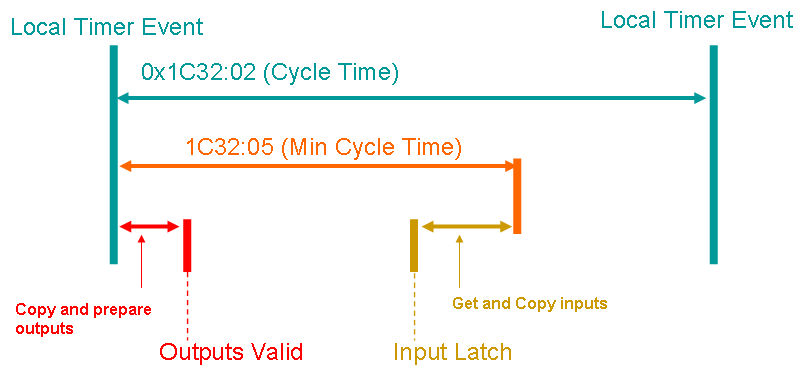
Tables "0x1C32 Free Run" and "0x1C33 Free Run" explain the application of these objects in "Free Run" mode.
|
Subindex |
Description |
Flag |
Use |
Description/default value |
|---|---|---|---|---|
|
1 |
Synchronization Type |
r or rw |
required |
0x00: Free Run |
|
2 |
Cycle Time |
r or rw |
optional |
Local cycle time from application controller |
|
3 |
Shift Time |
-- |
-- |
|
|
4 |
Synchronization Types supported |
r |
required |
Bit 0: Free Run supported |
|
5 |
Minimum Cycle Time |
r |
conditional |
required if 0x1C32:02 variable |
|
6 |
Calc and Copy Time |
-- |
-- |
|
|
7 |
-- |
-- |
-- |
|
|
8 |
Get Cycle Time |
-- |
-- |
|
|
9 |
Delay Time |
-- |
-- |
|
|
10 |
SYNC0 Cycle Time |
-- |
-- |
|
|
11 |
Cycle Time Too Small |
-- |
-- |
|
|
12 |
SM-Event missed |
-- |
-- |
|
|
13 |
Shift Time Too Short |
-- |
-- |
|
|
14 |
RxPDO Toggle Failed |
-- |
-- |
|
|
31:15 |
-- |
-- |
-- |
|
|
32 |
Sync Error |
-- |
-- |
|
Table 2: 0x1C32 Free Run
|
Subindex |
Description |
Flag |
Use |
Description/default value |
|---|---|---|---|---|
|
1 |
Synchronization Type |
r or rw |
required |
0x00: Free Run |
|
2 |
Cycle Time |
r or rw |
optional |
same value as 0x1C32:02 |
|
3 |
Shift Time |
-- |
-- |
|
|
4 |
Synchronization Types supported |
r |
required |
same value as 0x1C32:04 |
|
5 |
Minimum Cycle Time |
r |
conditional |
same value as 0x1C32:05 |
|
6 |
Calc and Copy Time |
-- |
-- |
|
|
7 |
-- |
-- |
-- |
|
|
8 |
Get Cycle Time |
-- |
-- |
|
|
9 |
Delay Time |
-- |
-- |
|
|
10 |
SYNC0 Cycle Time |
-- |
-- |
|
|
11 |
Cycle Time Too Small |
-- |
-- |
|
|
12 |
SM-Event missed |
-- |
-- |
|
|
13 |
Shift Time Too Short |
-- |
-- |
|
|
14 |
RxPDO Toggle Failed |
-- |
-- |
|
|
31:15 |
-- |
-- |
-- |
|
|
32 |
Sync Error |
-- |
-- |
|
Table 3: 0x1C33 Free Run
Operation mode 2 - Synchronous with SM event
The local cycle is started when the SM2 event [with cyclical outputs] or the SM3 event [without cyclical outputs] is received.
If the outputs are available, the slave is generally synchronized with the SM2 event. If no outputs are available, the slave is synchronized with the SM3 event, e.g. for cyclical inputs.
In this mode the following options are available:
Synchronous with SM2/3 event
The local cycle is started when the SM2/3 event is received.
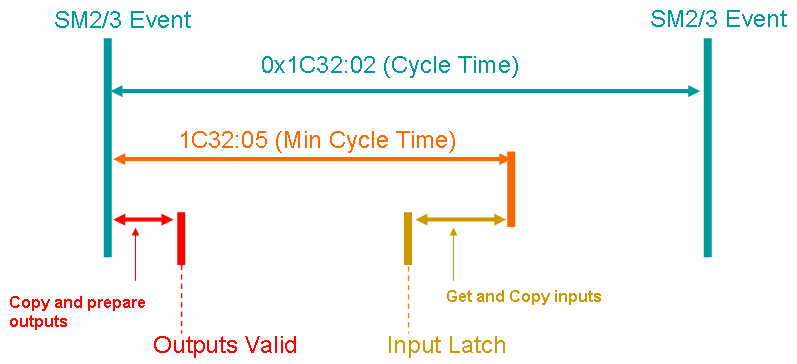
Tables "0x1C32 synchronous with SM 2/3 event" and "0x1C33 synchronous with SM 2/3 event" explain the application of these objects in mode "Synchronous with SM 2/3 event".
Subindex | Description | Flag | Use | Description/default value |
|---|---|---|---|---|
1 | Synchronization Type | r or rw | required | 0x01: Synchronous - synchronized with SM 2 event |
2 | Cycle Time | r or rw | optional | Communication cycle time |
3 | Shift Time | -- | -- |
|
4 | Synchronization Types supported | r | required | Bit 1: Synchronous SM supported |
5 | Minimum Cycle Time | r | required |
|
6 | Calc and Copy Time | -- | -- |
|
7 | -- | -- | -- |
|
8 | Get Cycle Time | rw | conditional**** |
|
9 | Delay Time | -- | -- |
|
10 | SYNC0 Cycle Time | -- | -- |
|
11 | Cycle Time Too Small | r | required |
|
12 | SM-Event Missed | r | optional |
|
13 | Shift Time Too Short | -- | -- |
|
14 | RxPDO Toggle Failed | r | optional |
|
31:15 | -- | -- | -- |
|
32 | Sync Error | r | conditional | Supported if "SM Event Missed" Counter is used |
**** used in synchronous mode or in DC mode with variable cycle time
Table 4: 0x1C32 synchronous with SM 2/3 event
Subindex | Description | Flag | Use | Description/default value |
|---|---|---|---|---|
1 | Synchronization Type | r or rw | required | 0x01: Synchronous - synchronized with SM 3 event (for transfer of inputs in SAFE-OP and OP status) 0x22: Synchronous - synchronized with SM 2 event (for transfer of outputs in SAFE-OP and OP status) |
2 | Cycle Time | r or rw | optional | same value as 0x1C32:02 |
3 | Shift Time | -- | -- |
|
4 | Synchronization Types supported | r | required | same value as 0x1C32:04 |
5 | Minimum Cycle Time | r | required | same value as 0x1C32:05 |
6 | Calc and Copy Time | -- | -- |
|
7 | -- | -- | -- |
|
8 | Get Cycle Time | rw | conditional**** | same value as 0x1C32:08 |
9 | Delay Time | -- | -- |
|
10 | SYNC0 Cycle Time | -- | -- |
|
11 | Cycle Time Too Small | r | required | same value as 0x1C32:0B |
12 | SM-Event missed | r | optional | same value as 0x1C32:0C |
13 | Shift Time Too Short | -- | -- |
|
14 | RxPDO Toggle Failed | r | optional | same value as 0x1C32:0E |
31:15 | -- | -- | -- |
|
32 | Sync Error | r | conditional | same value as 0x1C32:20 |
**** used in synchronous mode or in DC mode with variable cycle time
Table 5: 0x1C33 synchronous with SM 2/3 event
Synchronous with SM2/3 event, shifting of the "Input Latch" time
The input data should be logged as close as possible to the next SM2/3 event, in order to make the most current input data available to the control system (master). This can be achieved by shifting the "Input Latch" time closer to the SM2/3 event through modification of the "Shift Time" (0x1C33:03).
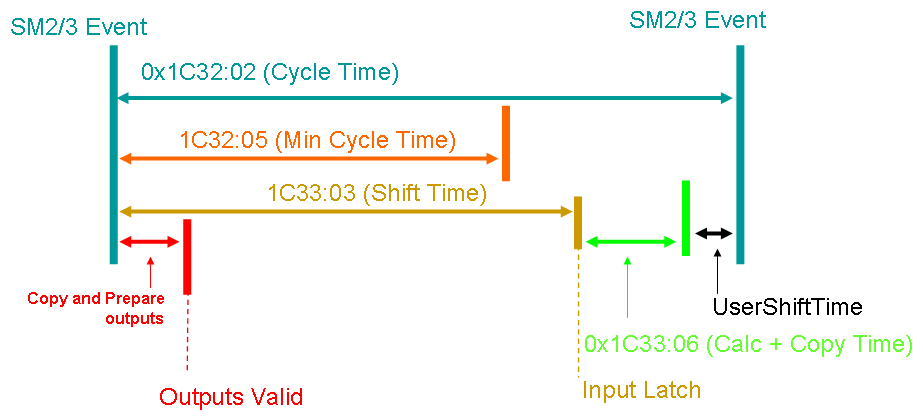
Tables "0x1C32 synchronous with SM 2/3 event, shifting of Input Latch" and "0x1C33 synchronous with SM 2/3 event, shifting of Input Latch" explain the application of these objects in mode "Synchronous with SM 2/3 event, if shifting of "Input Latch".
Subindex | Description | Flag | Use | Description/default value |
|---|---|---|---|---|
1 | Synchronization Type | r or rw | required | 0x01: Synchronous - synchronized with SM 2/3 event |
2 | Cycle Time | r or rw | optional | Communication cycle time |
3 | Shift Time | -- | -- |
|
4 | Synchronization Types supported | r | required | Bit 1: Synchronous SM supported |
5 | Minimum Cycle Time | r | required |
|
6 | Calc and Copy Time | -- | -- |
|
7 | -- | -- | -- |
|
8 | Get Cycle Time | rw | conditional**** |
|
9 | Delay Time | -- | -- |
|
10 | SYNC0 Cycle Time | -- | -- |
|
11 | Cycle Time Too Small | r | required |
|
12 | SM-Event missed | r | optional |
|
13 | Shift Time Too Short | -- | -- |
|
14 | RxPDO Toggle Failed | r | optional |
|
31:15 | -- | -- | -- |
|
32 | Sync Error | r | conditional | Supported if SM Event Missed Counter is used |
**** used in synchronous mode or in DC mode with variable cycle time
Table 6: 0x1C32 Synchronous with SM 2/3 event, shifting of the "Input Latch" time"
Subindex | Description | Flag | Use | Description/default value |
|---|---|---|---|---|
1 | Synchronization Type | r or rw | required | 0x01: Synchronous - synchronized with SM 3 event (only if inputs are available) 0x22: Synchronous with SM2 event (if outputs are available) |
2 | Cycle Time | r or rw | optional | same value as 0x1C32:02 |
3 | Shift Time | rw | required |
|
4 | Synchronization Types supported | r | required | same value as 0x1C32:04 |
5 | Minimum Cycle Time | r | required | same value as 0x1C32:05 |
6 | Calc and Copy Time | r | required |
|
7 | -- | -- | -- |
|
8 | Get Cycle Time | rw | conditional**** | same value as 0x1C32:08 |
9 | Delay Time | -- | -- |
|
10 | SYNC0 Cycle Time | -- | -- |
|
11 | Cycle Time Too Small | r | required | same value as 0x1C32:0B |
12 | SM-Event missed | r | optional | same value as 0x1C32:0C |
13 | Shift Time Too Short | -- | -- |
|
14 | RxPDO Toggle Failed | r | optional | same value as 0x1C32:0E |
31:15 | -- | -- | -- |
|
32 | Sync Error | r | conditional | same value as 0x1C32:20 |
**** used in synchronous mode or in DC mode with variable cycle time
Table 7: 0x1C33 Synchronous with SM 2/3 event, shifting of the "Input Latch" time"
Operation mode 3 - DC mode (distributed clock mode)
Practical aspects of the synchronization of several EtherCAT slaves with each other and with the EtherCAT master were already described above. This section provides information about the internal parameter for the following operation modes:
DC mode (synchronous with SYNC0 event)
The local cycle is started when the SYNC0 event is received. The process data frame must be fully processed in the slave before the next SYNC0 event is received.
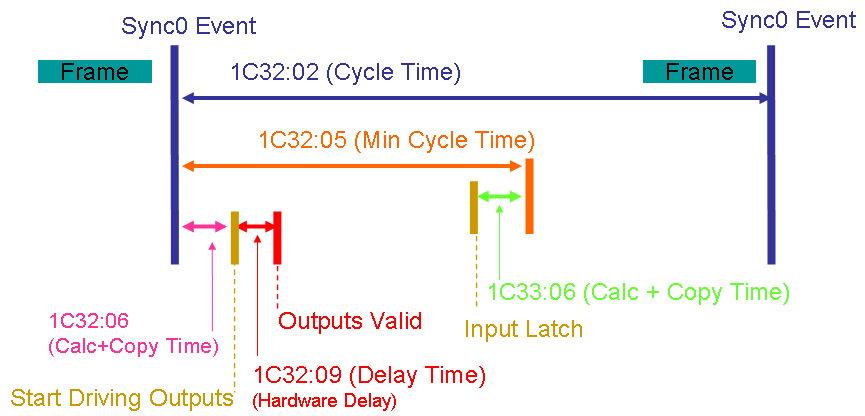
Tables "0x1C32 DC mode" and "0x1C33 DC mode" explain the application of these objects in DC mode.
Subindex | Description | Flag | Use | Description/default value |
|---|---|---|---|---|
1 | Synchronization Type | r or rw | required | 0x02: DC SYNC0 - synchronized with SYNC0 event |
2 | Cycle Time | r | optional | SYNC0 cycle time (register 0x09A3:0x09A0) Time between two SYNC0 events |
3 | Shift Time | -- | -- |
|
4 | Synchronization Types supported | r | required | Bit 3:2: DC supported: |
5 | Minimum Cycle Time | r | required |
|
6 | Calc and Copy Time | r | required |
|
7 | -- | -- | -- |
|
8 | Get Cycle Time | rw | conditional**** |
|
9 | Delay Time | r | required |
|
10 | SYNC0 Cycle Time | -- | -- |
|
11 | Cycle Time Too Small | r | required |
|
12 | SM-Event missed | r | optional |
|
13 | Shift Time Too Short | -- | -- |
|
14 | RxPDO Toggle Failed | r | optional |
|
31:15 | -- | -- | -- |
|
32 | Sync Error | r | conditional | Supported if SM Event Missed Counter is used |
**** used in synchronous mode or in DC mode with variable cycle time
Table 8: 0x1C32 DC mode
Subindex | Description | Flag | Use | Description/default value |
|---|---|---|---|---|
1 | Synchronization Type | r | required | 0x02: DC SYNC0 - synchronized with SYNC0 event |
2 | Cycle Time | r | optional | same value as 0x1C32:02 |
3 | Shift Time | -- | -- |
|
4 | Synchronization Types supported | r | required | same value as 0x1C32:04 |
5 | Minimum Cycle Time | r | required | same value as 0x1C32:05 |
6 | Calc and Copy Time | r | required |
|
7 | -- | -- | -- |
|
8 | Get Cycle Time | rw | conditional**** | same value as 0x1C32:08 |
9 | Delay Time | -- | -- |
|
10 | SYNC0 Cycle Time | -- | -- |
|
11 | Cycle Time Too Small | r | required | same value as 0x1C32:0B |
12 | SM-Event missed | r | optional | same value as 0x1C32:0C |
13 | Shift Time Too Short | -- | -- |
|
14 | RxPDO Toggle Failed | r | optional | same value as 0x1C32:0E |
31:15 | -- | -- | -- |
|
32 | Sync Error | r | conditional | same value as 0x1C32:20 |
**** used in synchronous mode or in DC mode with variable cycle time
Table 9: 0x1C33 DC mode
DC mode, shifting of on "Outputs Valid" and/or "Input Latch"
The "Outputs Valid" time can be delayed through the "Shift Time" (0x1C32:03 = 0x02) or the SYNC1 event (0x1C32:01 = 0x03). The "Shift Time" describes the time between the SYNC0 event and the "Outputs Valid" time, while the SYNC1 cycle time describes the time until the "Start Driving Outputs" time.
The "Input Latch" time can either be delayed through the "Shift Time" (0x1C33:03 = 0x02) or the SYNC1 event (0x1C33:01 = 0x03). In this case the "Shift Time" describes the time between the SYNC0 event and the "Input Latch" time, while the SYNC1 cycle time describes the time until the "Start Latch" time.
The SYNC1 signal can either be used for shifting the "Outputs Valid" or "Input Latch" time.
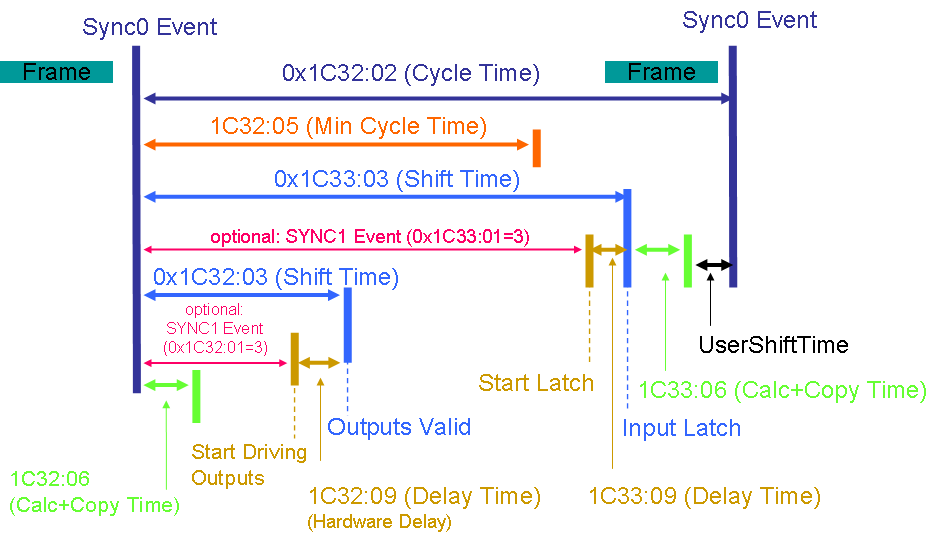
Tables "0x1C32 DC mode, shifting of inputs/outputs" and "0x1C33 DC mode, shifting of inputs/outputs" explain the application of these objects in DC mode with shifting of inputs/outputs.
Subindex | Description | Flag | Use | Description/default value |
|---|---|---|---|---|
1 | Synchronization Type | r or rw | required | If "Shift Time" is used for delaying the "Outputs Valid" time: If "SYNC1" signal is used for delaying the "Outputs Valid" time: |
2 | Cycle Time | r | required | SYNC0 cycle time (register 0x09A3:0x09A0) Time between two SYNC0 events |
3 | Shift Time | r or rw | required | The input is writeable if the "Shift Time" is used for shifting the "Outputs Valid" time If SYNC1 is used for shifting the "Outputs Valid" time, the SYNC1 cycle time + delay time (0x1C32:09) can be copied by the slave application into this entry. |
4 | Synchronization Types supported | r | required | Bit 3:2: DC supported:
If "Shift Time" is used for shifting the "Outputs Valid" time: If "SYNC1" signal is used for shifting the "Outputs Valid" time: |
5 | Minimum Cycle Time | r | required |
|
6 | Calc and Copy Time | r | required |
|
7 | -- | -- | -- |
|
8 | Get Cycle Time | rw | conditional**** |
|
9 | Delay Time | r | required |
|
10 | SYNC0 Cycle Time | -- | -- |
|
11 | Cycle Time Too Small | r | required |
|
12 | SM-Event missed | r | optional |
|
13 | Shift Time Too Short | r | optional |
|
14 | RxPDO Toggle Failed | r | optional |
|
31:15 | -- | -- | -- |
|
32 | Sync Error | r | conditional | Supported, if "SM Event Missed" or "Shift Time Too Short" counter is used |
**** used in synchronous mode or in DC mode with variable cycle time
Table 10: 0x1C32 DC mode, shifting of inputs/outputs
Subindex | Description | Flag | Use | Description/default value |
|---|---|---|---|---|
1 | Synchronization Type | r or rw | required | If "Shift Time" is used for delaying the "Input Latch" time: If "SYNC1" signal is used for delaying the "Input Latch" time: |
2 | Cycle Time | r | required | same value as 0x1C32:02 |
3 | Shift Time | r or rw | required | The input is writeable if the "Shift Time" is used for shifting the "Input Latch" time If SYNC1 is used for shifting the "Input Latch" time, the SYNC1 cycle time + delay time (0x1C33:09) can be copied by the slave application into this entry. |
4 | Synchronization Types supported | r | required | Bit 3:2: DC supported:
If "Shift Time" is used for shifting the "Input Latch" time: If "SYNC1" signal is used for shifting the "Outputs Valid" time: |
5 | Minimum Cycle Time | r | required | same value as 0x1C32:05 |
6 | Calc and Copy Time | r | required |
|
7 | -- | -- | -- |
|
8 | Get Cycle Time | rw | conditional**** | same value as 0x1C32:08 |
9 | Delay Time | r | conditional | This is used if the "SYNC1" signal is used for shifting the "Input Latch" time |
10 | SYNC0 Cycle Time | -- | -- |
|
11 | Cycle Time Too Small | r | required | same value as 0x1C32:0B |
12 | SM-Event missed | r | optional | same value as 0x1C32:0C |
13 | Shift Time Too Short | r | optional | same value as 0x1C32:0D |
14 | RxPDO Toggle Failed | r | optional | same value as 0x1C32:0E |
31:15 | -- | -- | -- |
|
32 | Sync Error | r | conditional | same value as 0x1C32:20 |
**** used in synchronous mode or in DC mode with variable cycle time
Table 11: 0x1C33 DC mode, shifting of inputs/outputs
Distributed clocks - application with subordinate controller cycle
For slaves with fast local cycle times (e.g. control loops) the cycle time of the application controller may be significantly faster than the communication cycle time and/or the SYNC0 cycle time. This is the case with Beckhoff XFC oversampling terminals, for example.
In this case two synchronization features are used:
- Shifting of the "Outputs Valid" time
- Shifting of the "Input Latch" time
DC, subordinate µC cycle, shifting of "Outputs Valid" and/or "Input Latch"
The "SYNC0" signal is used as a trigger for the local µC cycle. The "Outputs Valid" and "Input Latch" time is triggered by the SYNC1 event and can only be shifted by the "Output Shift Time" or "Input Shift Time".
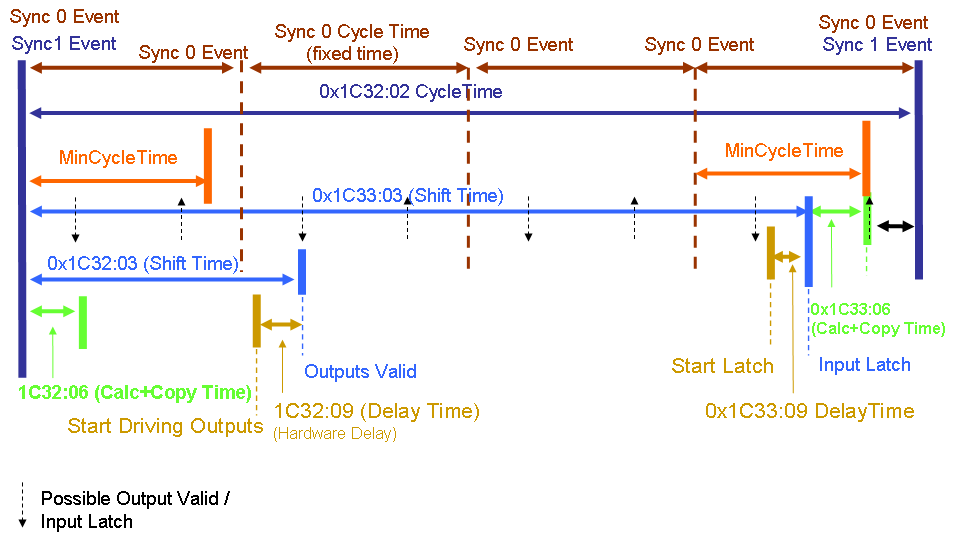
Tables "01x32C32 DC mode, subordinate µC cycles, shifting of inputs/outputs" and "01x33C32 DC mode, subordinate µC cycles, shifting of inputs/outputs" explain the application of these objects in DC mode for subordinate µC cycles and shifting of the "Outputs Valid"/"Input Latch" time.
Subindex | Description | Flag | Use | Description/default value |
|---|---|---|---|---|
1 | Synchronization Type | r or rw | required | 0x03: DC SYNC1 - synchronized with SYNC1 event |
2 | Cycle Time | r or rw | required | SYNC1 cycle time (register 0x09A7:0x09A4) Time between two SYNC1 events SYNC1 cycle time can be copied by the slave application to this entry. |
3 | Shift Time | rw | optional |
|
4 | Synchronization Types supported | r | required | Bit 3:2: DC supported:
Bit 5:4: shift settings 00 = no output time shift |
5 | Minimum Cycle Time | r | required |
|
6 | Calc and Copy Time | r | required |
|
7 | -- | -- | -- |
|
8 | Get Cycle Time | rw | conditional**** |
|
9 | Delay Time | r | required |
|
10 | SYNC0 Cycle Time | r | required |
|
11 | Cycle Time Too Small | r | required |
|
12 | SM-Event missed | r | optional |
|
13 | Shift Time Too Short | r | optional |
|
14 | RxPDO Toggle Failed | r | optional |
|
31:15 | -- | -- | -- |
|
32 | Sync Error | r | conditional | Supported, if "SM Event Missed" or "Shift Time Too Short" counter is used |
**** used in synchronous mode or in DC mode with variable cycle time
Table 12: 0x1C32 DC mode, subordinate µC cycles, shifting of inputs/outputs
Subindex | Description | Flag | Use | Description/default value |
|---|---|---|---|---|
1 | Synchronization Type | r or rw | required | 0x01: DC SYNC1 - synchronized with SYNC1 event |
2 | Cycle Time | r | required | same value as 0x1C32:02 |
3 | Shift Time | r | optional |
|
4 | Synchronization Types supported | r | required | Bit 3:2: DC supported:
Bit 5:4: shift settings 00 = no input time shift |
5 | Minimum Cycle Time | r | required | same value as 0x1C32:05 |
6 | Calc and Copy Time | r | required |
|
7 | -- | -- | -- |
|
8 | Get Cycle Time | rw | conditional**** | same value as 0x1C32:08 |
9 | Delay Time | r | required |
|
10 | SYNC0 Cycle Time | r | required | same value as 0x1C32:0A |
11 | Cycle Time Too Small | r | required | same value as 0x1C32:0B |
12 | SM-Event missed | r | optional | same value as 0x1C32:0C |
13 | Shift Time Too Short | r | optional | same value as 0x1C32:0D |
14 | RxPDO Toggle Failed | r | optional | same value as 0x1C32:0E |
31:15 | -- | -- | -- |
|
32 | Sync Error | r | conditional | same value as 0x1C32:20 |
**** used in synchronous mode or in DC mode with variable cycle time
Table 13: 0x1C33 DC mode, subordinate µC cycles, shifting of inputs/outputs